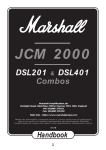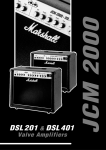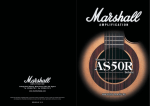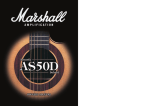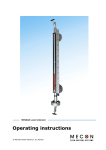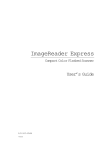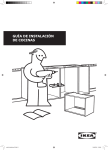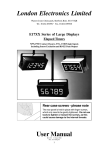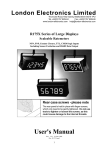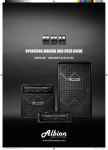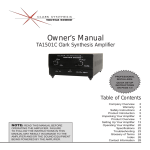Download Marshall Amplification JCM 2000 TSL 60 Specifications
Transcript
Marshall Amplification plc Denbigh Road, Bletchley, Milton Keynes, MK1 1DQ, England Tel : [01908] 375411 Fax : [01908] 376118 Web Site - http://www.marshallamps.com Whilst the information contained herein is correct at the time of publication, due to our policy of constant improvement and development, Marshall Amplification plc reserve the right to alter specifications without prior notice. M0260 / 2 / 99 BOOK 00053-01 / 5 /02 TSL 60, TSL 601 & TSL 602 Valve Amplifiers ENGLISH DEUTSCH Pages Pages 13 13 -- 18 18 FRANÇAIS Pages Pages 19 19 -- 24 24 JAPANESE Pages Pages 25 25 -- 30 30 From Jim Marshall I would like to personally thank you for selecting one of our JCM2000 Triple Super Lead valve amplifiers. Valve Amplifiers ESPAÑOL Pages Pages 77 -- 12 12 TSL 60, TSL 601 & TSL 602 ENGLISH Pages Pages 11 -- 66 Since I started Marshall Amplification in 1962 I have witnessed some incredible breakthroughs and advances in amplifier design technology, such as master volume amps, switchable channels, reverb, MIDI technology, speaker emulation and digital effects processing, to name just a few. These may seem like every day features nowadays but this certainly wasn’t always the case. However, the same values that were present in the first Marshalls are still here today. That is, solid workmanship, reliability, stylish looks and above all great Marshall tone. The TSL60, TSL601 and TSL602 are our latest all valve amplifiers and as such are really direct descendants of our classic all valve amps. Combining all of the aforementioned values plus a few extra attributes such as versatility, switchable channels, reverb, a big sound and of course, I am proud to say, all of the magical Marshall tone that you could want. The JCM2000 range is truly a testament to the Marshall legacy of great guitar products. I would like to wish you every success with all of your musical endeavours and also your new Marshall JCM2000 Triple Super Lead valve amplifier, which I am sure you will find a pleasure to play for many years to come. Yours Sincerely, 1 WARNING: This apparatus must be earthed! A B C D E F G H I J PLEASE read this instruction manual carefully before switching on. ALWAYS use the supplied mains lead, if a replacement is required please contact your authorised Marshall Dealer. NEVER attempt to by-pass the fuses or fit ones of the incorrect value. DO NOT attempt to remove the amplifier chassis, there are no user serviceable parts. Refer all servicing to qualified service personnel including replacement of fuses and valves. Servicing is required when the apparatus has been damaged in any way, such as when the power supply cord or plug is damaged, liquid has been spilled or objects have fallen into the apparatus, the apparatus has been exposed to rain or moisture, does not operate normally or has been dropped. NEVER use an amplifier in damp or wet conditions. No objects filled with liquids should be placed on the apparatus. When cleaning, only use a dry cloth. ALWAYS unplug this apparatus during lightning storms or if unused for long periods of time. PROTECT the power cord from being walked on or pinched particularly at plugs, convenience receptacles and at the point where they exit from the apparatus. DO NOT switch the amplifier on without the loudspeaker connected. ENSURE that any extension cabinets used are of the correct impedance. ➲ EUROPE ONLY - NOTE: This equipment has been tested and found to comply with the requirements of the EMC directive (Environments E1, E2 and E3 EN 55103-1/2) and Low Voltage directive in the E.U. ➲ EUROPE ONLY - NOTE: The Peak Inrush current for the TSL60, TSL601 & TSL602 is 33 amps. ➲ CAUTION: Any changes or modifications not expressly approved by the party responsible for compliance may void the user’s authority to operate the equipment. ➲ NOTE: It is recommended that all audio cables, with the exception of the speaker lead, used to connect to the TSL60, TSL601 & TSL602 are of a high quality screened type. These should not exceed 10 metres in length. Always use a non-screened Marshall approved speaker lead when connecting an extension cabinet to these units. ➲ WARNING: Do not obstruct ventilation grilles and always ensure free movement of air around the amplifier! USA ONLY - DO NOT defeat the purpose of the polarised or grounding type plug. A polarised plug has two blades with one wider than the other. A grounding type plug has two blades and a third grounding prong. The wide blade or the third prong is provided for your safety. When the provided plug does not fit into your outlet, consult an electrician for replacement of the obsolete outlet. FOLLOW ALL INSTRUCTIONS AND HEED ALL WARNINGS KEEP THESE INSTRUCTIONS ! Introduction With the introduction of the Marshall JCM2000 range of Dual and Triple Super Lead heads and combos, from 20 watts through to 100 watts, the quintessential definition of ultimate tone and usable features has been rewritten. This range of great amps has now been completed with the 60 watt range of Triple Super Lead amps, the TSL60 head, the TSL601 1x12” combo, and the TSL602 2x12” combo. They will cover any playing situation, from studio to full concert stages, whilst maintaining excellent portability. The TSL60 range offers three channel functionality, covering Clean, Crunch, and Lead, plus all points in between thanks to the overlapping sound spectrum of each channel. Added to that are dual reverb controls for the long spring ‘Sound Enhancements’ Reverb, Parallel FX loop with level, and remote switching plus Mix control, Emulated D.I. output with silent recording facility, also Deep and Presence controls. Not to mention the unmistakable warmth and TONE of an all valve Marshall amp. 2 TSL60, TSL601 & TSL602 Front Panel Features (pages 32 - 35) ✪ User Hint - where you see text starting with this sign, we have described some slight technical paraphenalia in order for you to understand what is going on inside your amp and we hope will help you in creating the tone that is best for you and your amp. control is advanced (especially with higher gain control settings) the sound will become more ‘singing’ in a blues/traditional rock kind of way. But if the mid control is backed off towards (or even) zero the gain emphasis is placed on the treble and bass controls and gives more to work on, especially on cleaner, lower gain settings, as would be the case for country, jazz, or good old chord strumming. 1. Input Jack As most manuals state, plug your guitar in here. A good starting point is to set these three controls to their ‘midway’ position and by experimenting with the ‘feel’ of how they interact with the amp, build up a wide palette of tones for future use. ✪ User Hint - Amusement aside, it is worthwhile remembering that you should use a high quality guitar lead to achieve optimum performance. If you are unsure what constitutes a high quality lead then most good music stores should be able to give you good advice, but remember, it may not be the cheapest one going! 4. Channel Switching The channels of your TSL60 range amp can either be switched from the front panel, or via an external footswitch - connection of the footswitch is described later. It is also worth pointing out here that how an amp sounds is VERY dependent on the type of guitar you use. For instance, a guitar with humbucker type pick-ups is not going to sound as open and clean as one with single coil type pick-ups, yet will provide that great mid range bark that we are accustomed to for rock playing. The front panel switching arrangement consists of three LEDs (Green = Clean, Yellow = OD1, Red = OD2) and two pushswitches, marked CLN/OD and OD1/OD2. To select Clean the switch marked CLN/OD must be released to its out position (Green LED will be on). To select either OD1 or OD2, push the CLN/OD switch in and select either OD1 or OD2 by pushing or releasing the switch marked OD1/OD2 and the appropriate Yellow or Red LED will illuminate. To revert back to Clean, release the CLN/OD switch once more. Do not worry, you do not have to go through OD1 to reach OD2, these channels can be pre-selected. 2. Clean Gain This controls the preamp level of the clean channel, at lower settings the sound will be very clean and at higher settings the sound will start to ‘Crunch’ up in a traditional blues sort of way. In between, around midway, depending on what type of guitar you are using, you will find some great semiclean/semi-crunch tones, just like those great vintage amps that had minimal features, but great tone. ✪ User Hint - The supplied foot controller allows instant access to all three channels, but for proper operation both front panel switches must be pushed in. ✪ User Hint - there is a capacitor across the gain control that brightens up the tone when set to lower levels. This helps to ‘cut’ through at low volumes and adds ‘twang’ to the tone. As you bring up the gain control the effect of this decreases and the tone becomes fatter. If you find the tone too thin with the gain control down either take some of the high end off with the treble control, or alternatively, bring the clean gain control up until you achieve the depth of tone you want and then control the volume of the amp with the ‘master volume’ control. 5. Crunch Channel Gain (OD1 - Yellow LED) This controls the amount of gain drive available for the crunch overdrive channel, from mildly almost clean crunch to saturated overdrive, depending where this control is set, i.e. lower is less and higher is more. Wherever this control is set is going to give you a wide palette of tones to work with, depending on the type of guitar, EQ settings, how hard you push the power amp, etc. 3. Clean Treble, Mid, Bass These controls vary the E.Q. and voicing of the Clean channel. ✪ User Hint - For the more traditional Rock tone of driving the power amp hard, use less of this control and turn the Volume control up higher. Experiment and you should hear the differences in tone, then choose what is best for you. ✪ User Hint - These controls are early on in the amplifier chain and as such not only control the tone of the Clean channel, but also how the clean channel reacts ‘gain’ wise. For instance, if the mid 3 ENGLISH ENGLISH WARNING! - Important safety instructions This control adjusts the level of sound coming out of the overdrive preamp channel and allows you to balance it against the Clean channel. 12. Clean Reverb This controls the level of the internal spring reverb circuitry from a slight shimmer to a cavernous depth for the Clean channel only. 7. Lead Channel Gain (OD2 - Red LED) As 5 above but controlling the Lead channel gain, and making even more saturated tones available. 13. Overdrive Reverb 8. Lead Channel Volume Controls the reverb depth for both the Crunch and Lead channels. As 6 above, this control balances the output of the Lead channel. Remember that the Reverb has an on/off function on the foot controller. ✪ User Hint - When using the less gain/more level way of driving the power stage, keep the overdrive gain low and use this volume control to drive the power amp. 14. Master Presence Control This works on the power amp circuit, and enables you to brighten up the sound, especially useful when the room acoustics of where you are playing are very dead sounding. 9. Overdrive Treble, Middle, Bass As opposed to the ‘Clean’ channel, these controls are placed after the distortion generating circuitry of your amp and as such affect the texture of the tone, rather than the gain of the channel, especially when using high levels of preamp gain. 15. Deep Switch Pushing in this switch activates a unique Marshall circuit that expands the resonance of the speaker system used, and thus gives a very deep and resonant depth to the bass of your sound. ✪ User Hint - Although many textures are available from this relatively simple configuration, a good starting point (again) is to set everything midway. For a more modern ‘heavy’ tone, turn the mid control down and boost the treble and bass. For a more classic ‘rock’ tone bring back the mids and bring the treble and bass down a bit. 16. Master Volume This controls the overall volume level of the total amplifier, thus allowing you to set up the tone and balance of all three channels, and then setting the required suitable level for your requirements with just one control. Additionally, using this control allows you to turn up the gain of the clean channel for a warmer, crunchier sound, without having to have the full power of the amp blasting away. ✪ User Hint - When using the less gain / more volume approach, the tone controls can be used to help ‘push’ the power amp for a more refined tone. 10. Overdrive Tone Shift ✪ User Hint - As the (rear panel mounted) speaker emulated D.I. output is derived from this circuit you can balance the sound coming out of the loudspeaker from zero to full, whilst maintaining a constant level out of the D.I. output - ideal for silent recording, direct to the desk. Pushing in this switch reconfigures the components used in the tone forming circuit. By doing this the Mid frequency is shifted and deepened, which, depending on how you set up the tone controls will help you get a modern ‘scooped’ rock sound, i.e. cutting the Mid control. Even though this may not be your ‘thing’, the range of tones available can be very expressive in other ways. As always, experiment. it will save electricity. Also, if leaving your amp unused for a long time, always remember to disconnect your amp’s power cord from the mains supply, at the very least it will prevent someone else accidentily turning it on without realising. 18. Power Switch This turns the mains electricity that feeds your amp on and off. As stated before, turn this switch on for at least a minute or two before turning the Standby on, to allow your amp to warm up. ✪ User Hint - For environmental reasons at least, if leaving your amp for more than a normal gig type break or so, turn your amp off at this switch, TSL60, TSL601 & TSL602 Rear Panel Features (pages 32 - 35) 1. Footcontroller DIN Socket 6. FX Loop Return Jack This socket is used to connect the 5-way foot controller to the amplifiers control circuit. Connects the output of the external FX processor back into the TSL amp circuit. The footcontroller allows you to immediately switch between all three channels, turn the reverb on or off, and also the FX loop on or off. 7. Speaker Emulated D.I. Out XLR. Line level, balanced, emulated output signal for connection into PA or recording Mixing Desks etc. 2. Loudspeaker Output Select 8. H.T. Fuse - See specifications for correct value This switch selects the output impedance of the amplifier for either 8 or 16 ohm use, to match to alternate speaker systems. Although more on this will be covered later, it is important to remember that the internal loudspeaker(s) on the TSL601 and TSL602 combos is 16 ohms and that the amp must be set to match that (16 ohms). Of course the TSL60 head does not have any in built loudspeakers, but the impedance matching rule still applies This fuse protects your amp in the case of a fault occurring with any of the high voltage circuitry. The usual reason for this to blow is when an output valve has become faulty. 9. Mains Input Use the supplied power cord to connect your amp to the mains supply. 3. Loudspeaker Output Jacks 10. Mains Fuse - See specifications for correct value These are identified by having RED jack socket nuts, and connect the amplifier output to either the internal, or, external loudspeaker system. WARNING! At no time must the amplifier be allowed to run with no loudspeaker (or appropriate loudspeaker type load) connected to its output. Otherwise serious and expensive damage may occur. This fuse provides overall safety protection in the case of your amplifier developing a major electrical fault. ✪ User Hint - The fuses fitted to your amp are there to provide you with safety protection in the case of a fault developing. If they blow it means something is wrong, usually a valve is getting old, but under no circumstances fit a fuse of a different value to stop it from blowing, as this could be very expensive in terms of safety and cost. Remember, if a fuse blows, it has blown for a reason. 4. FX Loop Send Jack 17. Standby Switch This turns the high voltage feed to operate the valves on and off. 11. Master FX Mix ✪ User Hint - This switch should be used for (a) allowing the amp to warm up before turning the Standby on (at least a minute - preferably 2/3 minutes if possible) and (b) turn the Standby switch off when taking a break (rather than turning off the whole amp), thereby keeping your amp at the ‘ready’, without waiting for it to warm up again. Remember to do these two simple rules and your valves will love you for it and should last an awful lot longer before replacement is needed. This controls the balance of the return from the parallel FX loop (see rear panel details for connection) with the amps direct signal. ✪ User Hint - As the FX loop is of the parallel kind, this is where you should use time delay effects (i.e. echo, reverb, pitch shifting, chorus, etc.). For optimum use the direct signal in your processor should be turned to zero so that only the effect 4 Connects the TSL amp to the input of the external FX processor. 5. Loop Level Switch. LOUDSPEAKER SYSTEMS This switch alters the signal level present in the FX loop, allowing the connection and use of differing makes and standards of FX units. The nominal levels available are +4dBm (switch out) or -10dBv (switch in). The TSL601 and TSL602 combo amps are each fitted with exclusive Marshall 12” ‘Wolverine’ loudspeakers. The 601 having one 16ohm loudspeaker, and the 602 having two 8ohm units wired in series for 16ohm use. 5 ENGLISH ENGLISH signal is returned to the amp, this way the tone integrity of the direct amp signal is unimpaired. 6. Crunch Channel Volume ENGLISH These great sounding loudspeakers have been especially developed to work with your amp to produce the great tone that you expect from a Marshall amp. The 1x12” format makes for a very highly portable package that works great in most circumstances, whereas the 2x12” format gives even more coverage, but by neccesity, is obviously larger and heavier. However, if you require a bigger sound, or just a different one, there are numerous cabinets manufactured by Marshall that will interface with your TSL combo, with ultimate ease. WARNING! Never operate your TSL valve amp without a loudspeaker, or suitable loudspeaker type load, connected to the output, even when using the output Master Volume set to zero for silent recording. Otherwise expensive damage may occur! USING EFFECTS SYSTEMS The TSL60 series are fitted with two parallel wired loudspeaker jack sockets and a selector to switch between 16 ohms or 8 ohms. As the TSL601 and 602 combos have the internal speakers wired for 16ohms, the selector should be set for 16ohms as standard. If an extension speaker system is used in conjunction with the internal speakers then this should be of 16ohms impedance and the selector set for 8ohms. Obviously, if the internal loudspeakers are disconnected, then the selector should be set to match the connected speaker system. With the TSL60 head, obviously any 8 or 16ohm loudspeaker system can be used, providing it is properly matched to the amplifier output. For optimum use we recommend one of the Marshall range of cabinets, in particular the 1960 range of 4x12” cabinets. These being available with differing speaker options for varying tonality, see your dealer for advice. Floor type effects stomp boxes are designed to work in between a guitar and the input of an amp and should not be used in a parallel loop, otherwise some very weird and undesired effects could occur. For their best use, use them where they are designed to go. i.e. 1 x 16 ohm speaker = 16 ohm output 2 x 16 ohm speaker = 8 ohm output De Jim Marshall Me gustaría agradecerte personalmente el haber elegido uno de nuestros amplis JCM2000 Triple Super Lead a válvulas. Desde que comencé Marshall Amplification en 1962 he sido testigo de muchos avances e innovaciones increíbles en la tecnología y en el diseño de los amplificadores, tales como la inclusión de controles de volumen Master de salida, canales conmutables, reverb, tecnología MIDI, simulación de altavoces y procesadores digitales de efectos, por nombrar unos pocos. Hoy en día éstas pueden parecer prestaciones muy cotidianas, pero desde luego no lo fueron en su momento y su aparición supuso un gran paso adelante. A pesar de ello, los valores primordiales de los primeros Marshall permanecen en la actualidad. Estos valores son sólida construcción, fiabilidad, impresionante aspecto y, por encima de todo, el tremendo sonido Marshall. Los TSL60, 601 y 602 son nuestra última generación de amplis de válvulas y, como tales, son descendientes directos de nuestros clásicos. Combinan todos los valores antes mencionados con algunos atributos extra como versatilidad, canales conmutables, reverb, un gran sonido y, por supuesto -lo cual me enorgullece-, toda la magia del Factor Sonoro Marshall que le quieras pedir. La gama JCM2000 es el nuevo legado de los Grandes Equipos de Guitarra Marshall. 1 x 8 ohm speaker = 8 ohm output Quiero desearte éxito en todos tus proyectos musicales y felicitarte por tu nuevo Marshall JCM2000 Triple Super Lead, que estoy seguro que te acompañará muchos años. Un cordial saludo, 6 7 ESPAÑOL Your TSL combo amp is fitted with a parallel FX Loop, this is placed after the gain and distortion parts of the preamp and is the ideal place for inserting time varying effects, such as delay, digital reverb, chorus, pitch shifting, etc. By being a parallel loop, this means that the direct signal is kept within the TSL’s circuit and therefore your tone is not degraded by sending it outside the amp. To use the loop connect your effects processor (rack type units are better at this job) as described earlier, turn the effects units direct signal path off (the FX units manual will tell you how to do this), set up the unit to give you the effect you require and then balance your direct sound and effected sound using the FX MIX control on the front of your amp. Easy! 5 6 10 14 15 TSL601/602 Combo Front Panel 4 1 16 2 9 7 8 9 6 5 11 12 13 2 1 4 TSL601/602 Combo Rear Panel 9 10 32 8 7 3 33 17 18 13 12 11 9 8 7 6 5 3 2 1 TSL60 Head Front Panel 15 18 17 16 14 1 2 10 4 3 8 10 9 TSL60 Head Rear Panel 4 5 6 7 TSL60, TSL601, TSL602 SPECIFICATIONS Power Output 60 Watts RMS into 8 or 16 ohms Valve complement 4 x ECC83/12AX7 and 2 x EL34 Loudspeaker Type TSL60 (None), TSL601 (1x Marshall ‘Wolverine’ type WH-80-16, TSL602 (2x Marshall ‘Wolverine’ type WH-80-8 connected in series for 16 ohm operation Mains Requirement Preset for 117V~60Hz or 230V~50Hz Other variations to special order see local distributor for information. Mains Fuse T3AL - 120V or TI6AC - 230V H.T. Fuse T500mAL 34







